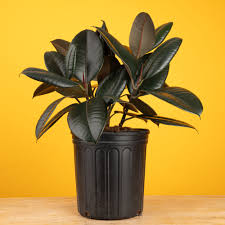Rubber Plants: Ficus Elastica for Every Gardener
Discover the beauty and adaptability of rubber plants, scientifically known as ficus elastica. Ideal for both novice and experienced gardeners, these striking plants enhance any indoor or outdoor space.
6/3/20255 min read


Understanding Rubber Plants
Rubber plants, scientifically known as Ficus elastica, are renowned for their striking foliage and adaptability, making them a favored choice among both novice and experienced gardeners. With their glossy, dark green leaves, the rubber plant adds a touch of elegance to any indoor or outdoor space. Originally native to Southeast Asia, these plants can grow quite tall in their natural habitat, often reaching heights of up to 100 feet; however, when cultivated indoors, they tend to stay much smaller, typically between 3 to 10 feet, depending on the variety and care received.
One of the primary characteristics of rubber plants is their thick, leathery leaves, which not only contribute to their ornamental appeal but also enable the plant to effectively conserve water. This makes them relatively low-maintenance, requiring only moderate water and indirect sunlight. Among the various varieties, rubber plants are available in diverse leaf shapes and colors, with some exhibiting variegated patterns that add to their charm. Popular types include the robust Ficus elastica 'Sabre' and the striking Ficus elastica 'Ruby,' both known for their unique aesthetics.
The benefits of rubber plants extend beyond their visual appeal. They are known for their air-purifying qualities, capable of filtering airborne toxins and improving indoor air quality. This characteristic makes them an excellent choice for homes and offices, where clean air is essential. To cultivate a thriving rubber plant, one should prioritize well-draining soil, moderate watering schedules, and a warm environment, ensuring temperatures remain between 60°F to 75°F. With the right care, rubber plants can flourish, providing both beauty and a pleasant atmosphere.
How to Locate a Rubber Plant Nursery Near You
Finding a rubber plant nursery near you can enhance your gardening experience and ensure that you acquire healthy plants. One of the most effective methods to locate these specialized nurseries is through online resources. Websites dedicated to gardening, plant care, and local businesses often have directories that list nurseries by location. Using search engines, type in terms like "rubber plant nursery near me" or "local plant nurseries" to view the results tailored to your area. Be sure to explore maps services, as they can provide details on nearby nurseries as well as reviews from previous customers.
Mobile applications designed for gardening enthusiasts are useful tools in your search. Apps like PlantSnap or Gardenia can help you identify local plant sellers by inputting your specific needs, such as the search for rubber plants. Additionally, these apps often allow users to share personal experiences, providing further insights into the quality of the nurseries.
Local classifieds also serve as an excellent resource for sourcing rubber plant nurseries. Websites like Craigslist or community bulletin boards often feature listings from local growers and retailers. By checking these platforms regularly, not only can you find nurseries but you may also discover individual sellers who specialize in rubber plants.
Lastly, leveraging social media and gardening communities can yield valuable recommendations. Joining gardening groups on platforms like Facebook or Reddit can connect you with fellow plant enthusiasts, many of whom can share their favorite local nurseries. They often share personal reviews, tips, and the best times to visit particular locations, which can significantly aid your search. Remember, once you find potential nurseries, verify their locations, hours of operation, and read customer reviews to ensure a satisfactory visit.
What to Consider When Buying Rubber Plants
When considering the purchase of rubber plants, several essential factors come into play. Firstly, the size of the plant is an important consideration, as it impacts both the aesthetics of your space and the ease of transportation. Rubber plants can be found in various sizes, from small saplings to larger, more mature specimens. Determine which size fits best in your home or office environment, taking into account the light conditions and space availability.
Health indicators are another critical aspect. A healthy rubber plant will exhibit vibrant green leaves devoid of any discoloration, signs of pests, or diseases. Inspect the leaves and the stem for any signs of rot or damage. Additionally, check the root system if possible; healthy roots should be firm and white or light tan in color. The overall appearance of the plant is vital for ensuring that your investment will thrive in your care.
Pricing varies significantly depending on the plant size, variety, and where you purchase the rubber plant. Researching prices ahead of time can help you to understand a fair range to expect. Consider local suppliers that specialize in rubber plants, as they are more likely to provide healthier options and better care than larger, national retailers. Choosing local suppliers not only supports the community but also allows you to assess the plants firsthand.
Seasonal availability can influence your decision as well. Some varieties of rubber plants might be more readily available during specific times of the year. It’s worthwhile to inquire with local nurseries about their stock and the best time to buy. If you are interested in negotiating prices, consider discussing purchase in bulk or asking about discounts for slightly imperfect plants, which can still bring beauty to your space. Ensuring a healthy purchase of your rubber plant will provide you with a rewarding experience as you nurture it in your home.
Caring for Your Rubber Plant After Purchase
Once you have acquired your rubber plant, proper care is essential to ensure its health and vibrancy. Understanding the plant's needs regarding watering, lighting, soil preferences, and pest management can significantly enhance its growth and longevity. Regularly observing and adjusting care routines based on seasonal changes also plays a crucial role in maintaining the well-being of your rubber plant.
Watering is one of the most critical aspects of rubber plant care. These plants thrive in moist soil, but overwatering can lead to root rot. It is best to allow the top inch of soil to dry out before watering again, typically every week or so, depending on the environment. During the winter months, when growth slows, watering frequency may decrease. Always ensure that the pot has adequate drainage to prevent standing water.
Lighting conditions are equally important. Rubber plants prefer bright, indirect light but can adapt to low light conditions. However, exposure to direct sunlight can scorch their leaves. If you notice the leaves beginning to lose their vibrancy or develop brown spots, consider adjusting their placement. Artificial light can supplement natural light if necessary, especially during the darker months.
Choosing the right soil is vital for your rubber plant’s health. A well-draining potting mix formulated for houseplants or aroid mixes often works well. Additionally, keep an eye out for common pests such as spider mites, mealybugs, and aphids. Regularly inspecting the leaves and treating infestations promptly with insecticidal soap or neem oil can help maintain your plant's health.
Seasonal care is essential as well. In the growing season, consider fertilizing your rubber plant every few weeks with a balanced, water-soluble fertilizer to encourage robust growth. As the seasons change, adjustments in care practices can make a significant difference in the plant's overall health. With attentive and informed care, your rubber plant can thrive as a vibrant addition to your home or garden.
